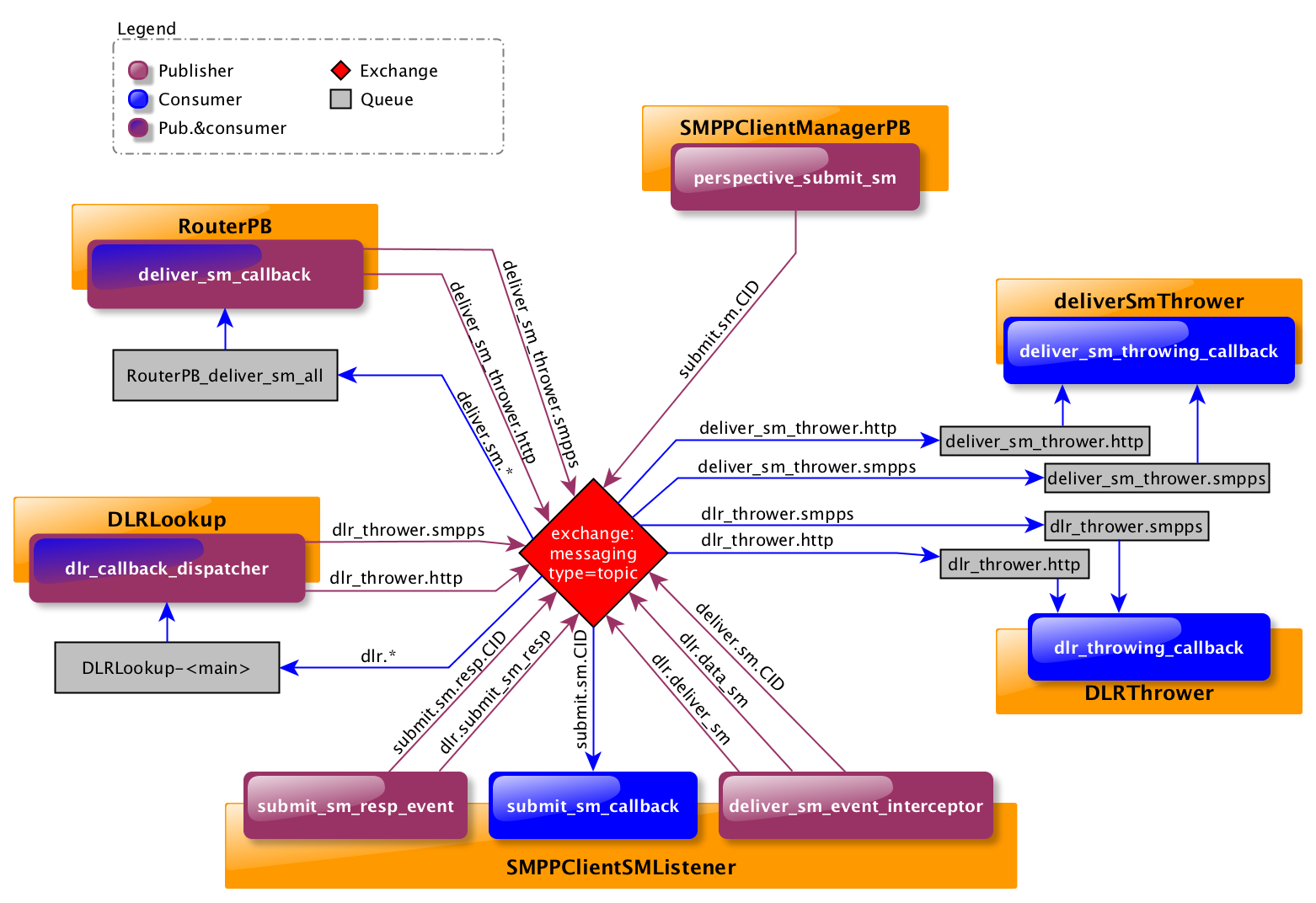Messaging flows#
Messaging is heavily relying on an AMQP broker using topics to queue messages for routing, delivering and acking back.
The AMQP broker is providing a strong store & forward queuing mechanism, through the following illustration you can see how every messaging component is asynchronously connected to the broker.

AMQP Messaging flows#
Six main actors are messaging through the “messaging” topic, their business logic are explained in the below paragraphs.
SMPPClientManagerPB#
This is a PerspectiveBroker (PB) responsible of managing SMPP Client connectors (list, add, remove, start, stop, send SMS, etc …), we’ll be only covering the latter (Send SMS).
When the perspective_submit_sm() is called with a SubmitSm PDU and destination connector ID, it will build an AMQP Content message and publish it to a queue named submit.sm.CID where CID is the destination connector ID.
Note
perspective_submit_sm() is called from HTTP API and SMPP Server API after they check with RouterPB for the right connector to send a SubmitSM to.
Every SMPP Connector have a consumer waiting for these messages, once published as explained above, it will be consumed by the destination connector’s submit_sm_callback() method (c.f. SMPPClientSMListener).
DLRLookup#
This is a consumer on the dlr.* AMQP route, added in v0.9, it’s main role is DLR map fetching from Redis database and publishing the dlr to the right thrower (http or smpp).
RouterPB#
This is another PerspectiveBroker (PB) responsible of routing DeliverSm messages, these are received through the SMPP client connector’s deliver_sm_event_interceptor() method (c.f. SMPPClientSMListener) which publish to deliver.sm.CID, the RouterPB main role is to decide whether to route DeliverSm messages to:
deliver_sm_thrower.smpps: if the message is to be delivered through SMPP Server API.
deliver_sm_thrower.http: if the message is to be delivered through a HTTP connector.
SMPPClientSMListener#
Every SMPP Client connector have one attached SMPPClientSMListener instance, it is responsible for handling messages exchanged through the SMPP Client connector using the following event catchers:
deliver_sm_event_interceptor#
Every received DeliverSm PDU is published directly to the broker with the following assumptions:
If it’s a SMS-MO message it will get published as an AMQP Content message to deliver_sm.CID where CID is the source connector ID, this message will be handled by the RouterPB.
If it’s a delivery receipt and if it were requested when sending the SubmitSm, it will get published as an AMQP Content message to dlr_thrower.http or dlr_thrower.smpps (depends on the used channel for sending initial SubmitSM) for later delivery by DLRThrower’s dlr_throwing_callback() method.
Note
deliver_sm_event_interceptor() will check for interception rules before proceding to routing, c.f. Interception for more details.
submit_sm_callback#
It is a simple consumer of submit.sm.CID where CID is its connector ID, it will send every message received through SMPP connection.
submit_sm_resp_event#
It is called for every received SubmitSmResp PDU, will check if the related SubmitSm was requiring a delivery receipt and will publish it (or not) to dlr_thrower.http or dlr_thrower.smpps (depends on the used channel for sending initial SubmitSM).
Note
There’s no actual reason why messages are published to submit.sm.resp.CID, this may change in future.
deliverSmThrower#
This is will through any received message from deliver_sm_thrower.http to its final http connector, c.f. Receiving SMS-MO for details and from deliver_sm_thrower.smpps to its final SMPP Server binding.
DLRThrower#
This is will through any received delivery receipt from dlr_thrower.http to its final http connector, c.f. Receiving DLR for details and from dlr_thrower.smpps to its final SMPP Server binding.